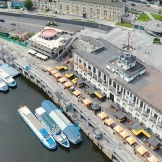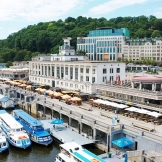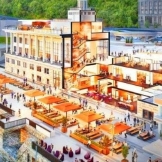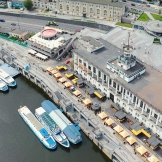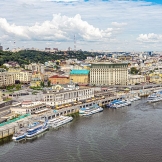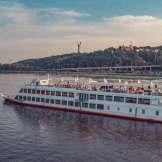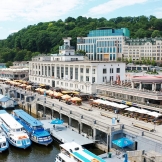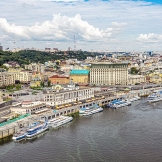For the first time I visited the Kyiv river port and visited the building of the Kyiv river station at the age of 14. The reason for this was one of the first cruises in my life on the wonderful ship General Vatutin. Even then, the port had a slightly shabby appearance and, as I understood it, did not fully fulfill its functions. Now the building has been completely restored and has completely different purposes ...
But let's take a closer look at the history and facts about the main port of the capital.
TRANSPORTATION
River transport in the capital began to develop actively in the 19th century. The harbor of the river port became the largest in the entire Russian Empire, and the berth line stretched for more than 3 km. Passenger transportation was carried out by a company owned by entrepreneur David Margolin. His company controlled nine waterways. According to some data, the volume of passenger transportation amounted to about 2 million passengers and more than 48 thousand tons of cargo per year. There was also a river station in Kyiv at the beginning of the century, but almost no information about it has been preserved.

At the peak of navigation (about 1990), 12 passenger ships of project 301 and 302 sailed along the Dnieper and Danube. These ships were built in Germany, by order of the USSR. And later they were upgraded to be able to carry out cruises in the coastal waters of the Black Sea.
During the USSR, cargo and passenger transportation along the Dnieper was carried out by the shipping company Ukrrichflot. After the privatization of Ukrrichflot on November 11, 1992, the volume of traffic began to fall.
From that moment on, the Ukrainian river fleet began to rapidly decrease. Passenger ships and vessels were sold abroad (mainly to Russia). Some ships were simply decommissioned and went for scrap.
1. Ship "Princess of the Dnieper" (previous name of the m/v "Evgeny Vuchetich")
Status: located in Ukraine
Company: Chervona Ruta
2. Ship "Zirka Dnepr" (previous name of m/v "Marshal Rybalko")
Status: located in Ukraine
Company: Chervona Ruta
3. Ship "Viking Sineus" (previous name of m/v "Mikhail Lomonosov")
Status: sold to Viking River Cruises, located in Ukraine
Company: Viking River Cruises
Built: 1979 (restored 2009)
4. Ship "Viking Akun" (previous name of m/v "Marshal Koshevoy")
Status: sold to Viking River Cruises, located in Russia
Company: Viking River Cruises
Built: 1979 (restored 2009)
5. Ship "Swan Lake" (previous name of m/v "General Vatutin")
Status: sold to Russia in 2017
Company: Skypoint limited
Year of construction: 1986

6. Ship "Pyotr Tchaikovsky" (previous name of m/v "Lesya Ukrainka")
Status: located in Ukraine
Company: Chervona Ruta
7. Ship "Russia" (previous name of m/v "Soviet Russia")
Status: sold to Russia
8. Ship "Mikhail Bulgakov" (previous name of m/v "Maxim Rylsky")
Status: sold to Russia
9. Ship "Andrey Rublev" (previous name of m/v "Nikolay Dobrolyubov")
Status: sold to Russia
10. Ship "Igor Stravinsky" (previous name of m/v "Akademik V. Glushkov")
Status: sold to Russia
11. Ship "Ivan Bunin" (previous name of m/v "Alexey Vatchenko")
Status: sold to Russia
12. Ship "General Lavrinenkov"
Status: sold to Russia
13. Ship “T.G. Shevchenko"
Status: sold to Russia
CRUISES
The Chervona Ruta cruise company managed to somehow maintain stability and leave ships in Ukraine. Thanks to the actions of the owner of the company, functional ships were not only left in Ukraine, but the ship was completely restored.

The company "Chervona Ruta" carried out cruises along the Dnieper River with a call to the Black Sea. Such cruises included ports: Kyiv, Cherkassy, Kanev, Zaporozhye, Dnepr, Kherson, Odessa, Sevastopol, Yalta.
Basically, such cruises were carried out for foreigners who wanted to immerse themselves in Ukrainian culture and visit some of the most touristic cities in Ukraine.
Unfortunately, due to the numerous events of 2014, cruises along the Dnieper have lost their relevance. Tourists canceled bookings, which caused a lot of problems. In the period from 2015 to 2021, there were attempts to rehabilitate cruises along the Dnieper on the ships of the Chervona Ruta company, as well as on the ship of the Viking River Cruises cruise company. But Russia's attack on Ukraine ruled out cruises.

In parallel, other companies also developed, offering pleasure cruises along the Dnieper, lasting from 1 to 4 hours (depending on the route). Cabins are not provided on these small motor ships, therefore, long trips were not planned on them.
WATER PUBLIC TRANSPORT
Until the 1990s, the Dnieper was fully used as a transport artery of Ukraine. The main transportation was carried out on rockets that developed a speed of 60-65 km / h. It was a fairly fast and comfortable mode of transport, which was used by many. During the period of "cheap fuel" quite a lot of passenger traffic was carried out. Over time, water transport still competed more with land transport, and traffic volumes decreased. In the end, during the difficult economic situation that developed in the 90s, transportation along the Dnieper had to be completely abandoned.

In 2009, a type of public transport forgotten for Kyiv was launched - the so-called river tram, for communication between the right and left banks of Kyiv. Of course, this ship was launched by the Nibulon company and its owner Vadatursky Alexey Afanasyevich. He brought a lot of innovations to shipping in Ukraine, and to the economy of Ukraine in general, and tried to develop cargo transportation by water despite all the obstacles.
The tram runs only during the warm season.
FREIGHT TRANSPORTATION
The basis of the port's activity is cargo transportation.

The Kyiv river port was used mainly for the transportation of grain, salt, timber, industrial goods. After the construction of the Dnieper cascade, the hydroelectric power station became accessible to large ships and actually turned into a transit port through which the cargoes of the ports of the Dnieper basin went. Cargoes from large-capacity vessels were reloaded to the fleet, which served the shallow part of the Dnieper and the Desna, and vice versa.
Today, the Kyiv River Port is an enterprise that has more than 1.5 thousand m of cargo berths equipped with modern loading and unloading facilities. The presence of railway tracks, convenient access for oversized vehicles are unique opportunities for processing cargo that arrives by water, rail and road transport.
Also, the Kyiv River Port is equipped with hydraulic structures, special devices for parking, processing and navigational maintenance of the fleet, coastal facilities, repair shops and has a river station in its structure, where river passenger and tourist transportation is carried out.
The structure of the Kyiv river port includes two cargo areas with both open and closed storage areas with a lot of office space. To ensure the efficient operation of cargo areas, the port has reloading mechanisms, frontal cranes with a lifting capacity of up to 20 tons, floating cranes - 5 tons, a hydraulic sand loader, auto- and electric loaders, as well as other mechanisms.
The Kyiv river port also has its own cargo fleet, which includes a self-propelled cargo fleet, a towing fleet, an auxiliary fleet, as well as a non-self-propelled fleet, to perform various types of work and service large cargo flows along the river. Dnieper.
We hope for a speedy end to the war and the resumption of not only the shipping industry in Ukraine, but also other important areas of tourism.
Today, the Kyiv River Port is an enterprise that has more than 1.5 thousand m of cargo berths equipped with modern loading and unloading facilities. The presence of railway tracks, convenient access for oversized vehicles are unique opportunities for processing cargo that arrives by water, rail and road transport.
Also, the Kyiv River Port is equipped with hydraulic structures, special devices for parking, processing and navigational maintenance of the fleet, coastal facilities, repair shops and has a river station in its structure, where river passenger and tourist transportation is carried out.
The structure of the Kyiv river port includes two cargo areas with both open and closed storage areas with a lot of office space. To ensure the efficient operation of cargo areas, the port has reloading mechanisms, frontal cranes with a lifting capacity of up to 20 tons, floating cranes - 5 tons, a hydraulic sand loader, auto- and electric loaders, as well as other mechanisms.
The Kyiv river port also has its own cargo fleet, which includes a self-propelled cargo fleet, a towing fleet, an auxiliary fleet, as well as a non-self-propelled fleet, to perform various types of work and service large cargo flows along the river. Dnieper.
We hope for a speedy end to the war and the resumption of not only the shipping industry in Ukraine, but also other important areas of tourism.
Share:






 Wait a few seconds...
Wait a few seconds...

